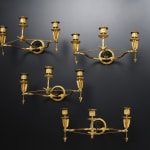André-Antoine Ravrio (attributed to)
Literature
Sylvie Chadenet "Les Styles Empire & Restauration", 1976, p. 74, pl. 2, illustrating a wall-light of the same design from a private collection. Jean-Pierre Samoyault, "Pendules et bronzes d'ameublement entrés sous le Premier Empire; Catalogue des Collections de Mobilier, Musée National du Château de Fontainebleau", 1989, pp. 136-138, pls. 104-109, illustrating six sets of similar wall-lights in Château de Fontainebleau.
A very fine set of four Empire gilt and patinated bronze three-light wall-lights attributed to André-Antoine Ravrio, each with a circular gilt beaded and anthemion banded backplate centred by a patinated lion mask holding in its jaw an extended bow, with a central arrow pulling the bow string taught with its point facing into the lion's mouth and its feathers issuing an upright candle branch with foliate cast vase-shaped nozzle above a circular drip pan, at either end of the bow two further candle holders, each with its shaft formed as an arrow with feathers below the conformingly shaped nozzles and drip pans
Paris, date circa 1810
Height 18 cm, width 37.5 cm, depth 27 cm. each.
Samoyault illustrates a number of similar wall-lights at Château de Fontainebleau by both Claude Galle (1759-1815) and André-Antoine Ravrio (1759-1814) but the closest in design to the present set are three pairs by Ravrio (Samoyault op. cit, p. 137, pl. 107) which were delivered to Fontainebleau in 1808 and 1809. These include the same backplate but as in all those examples at the Château do not include the bow; instead three inward facing arrows are caught in the lion's mouth and at the end of each, just short of the feathers, is a sphere supporting the candle nozzles of the same form as here. It was noted that in 1808 Ravrio delivered one of those pairs to the salon de l'appartement no 3, staircase C, cour de Princes', another pair to the salon de l'appartement no 1, staircase D of the same court and a third pair to the salon de l'appartement no 4, staircase E, again of the same court. In 1809 he delivered another pair to the salon du 3e logement de ministre no 5. In 1810 two of those pairs were in the Empress's salon d'étude and the third in the ministers' wing. Three other pairs of three-light wall-lights of similar design by Ravrio (Samoyault, p. 138, pl. 108) were delivered to Fontainebleau in 1810. These also had lion head backplates and arrow shafts but their feathers differed and the nozzles were fluted and bulbous. The pair by Galle were delivered to Fontainebleau in 1806 (Samoyault, p. 136, pl. 104); these had the same candle nozzles as here but only two arrows issuing from a male masked backplate.
André-Antoine Ravrio's (1759-1814) celebrated oeuvre included a variety of sumptuous bronze furnishings, from wall-lights and candelabra to vases, clock cases, statuettes and furniture mounts. One of the greatest French bronziers of his day, Ravrio was a highly successful businessman and an exceptionally gifted artist and designer. Having attended the Académie, he trained as a fondeur under his father André and on Pierre-Philippe Thomire's recommendation was introduced to the comte d'Artois, 1774. Three years later he was received as a maître-fondeur and afterwards joined J-B Disnematin-Dorat, a Parisian doreur-argenteur, whose business he succeeded.
Though Ravrio enjoyed success during Louis XVI's reign, he achieved far greater fame under Napoleon who appointed him his chief bronzier and for whom he supplied numerous bronzes for Fontainebleau and other Imperial palaces including the Tuileries, Saint-Cloud, Versailles, Compiègne and Rambouillet. Ravrio also worked for the Quirinal in Rome, Monte-Cavallo, for Stupinigi near Turin, King Ludwig of Holland and other notable figures.



